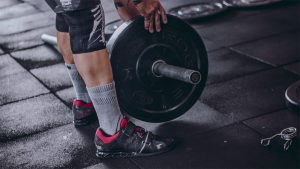Can Running Shoes Prevent Shin Splints?
Preventing shin splints is key for any athlete. This post explores shin splints and whether running shoes can prevent them.

Pixabay
The answer to this question is yes, running shoes can help prevent shin splints. While there is no way to completely eliminate the chance of shin splits happening to you, finding the right pair of running shoes is one of your best lines of defense.
Shin splints are the name for pain in your shin and lower leg after you have been running for extended periods of time. They occur most commonly after running on hard surfaces and can be quite painful. Shin splints are actually the most prevalent lower leg injury[1].
What are the Symptoms of Shin Splints?
Generally speaking, if you have shin splints, you’ll know it. If you are new to running, here are the symptoms to watch out for:
- Acute pain and/or tenderness from the knee down.
- Pain that gets worse after running for a short distance.
- Pain that gets worse if you flex your toes upward.
There are two types of shin splints, ones on the inside of the leg (medial shin splints), or ones on the outside of the leg (anterior shin splints.) Runners are not the only ones at risk – many athletes experience shin splints at one time or another.
What Running Shoes are Best for Preventing Shin Splints?
The best running shoes for you will be different than the best ones for your friends and family. It will depend on your personal style, gait, and cushioning needs. Your arches will also help determine what shoes are best for you. Going to a specialty store and speaking to one of their employees is a good way to determine what shoe will serve your feet best for running.
Stability is very important because it will help keep your foot in the proper place while you are running. This helps with your form, which in turn greatly reduces your risk for a variety of injuries. Like with any pair of shoes, make sure that they are comfortable before you buy.
Once you have found the perfect shoes, be aware that they will lose their cushioning over time. This can greatly increase your risk for shin splints. As a result, experts recommend replacing your running shoes every 300 to 400 miles.
If the shoes alone are cutting it for you, look into specialty insoles. Sometimes, lifting your heels up a bit so your calves do not need to stretch as much can make a world of difference.
Finding Running Shoes that Fit
Even the best running shoes cannot help you if they do not fit properly. Keep in mind that all manufacturers do not make their shoes the same way.
Some brands will not be a good match for you if you have high arches or wide feet. When finding your first pair of running shoes, avoid shopping online. You will need to try them on to get an idea of how well they will fit. Once you have found a brand that works well with your feet, buying replacements online should be okay.
How Else to Prevent Shin Splints
Going too hard, too fast is the biggest reason new runners experience shin splints. Even if you have found your ideal running shoes, you can hurt yourself if you increase your mileage and do not allow yourself enough time to recover. Doctors will tell you that shin splints are considered an overuse injury. On top of gradually increasing your miles, here are some other ways to prevent shin splints:
Run on soft surfaces if possible
It is common knowledge that running on concrete and other hard materials can be hard on your joints. It is a good idea to find a dirt or grass track to run on. If that is not an option, know that treadmills are easier on your legs than a sidewalk.
Do exercises to strengthen muscles in your calves and toes
People who are new to running often do not have strongly developed anterior tibialis muscles. It is these muscles that are responsible for flexing your foot upward. Simple exercises, such as toe raises, can help strengthen that muscle and prevent shin splints.
Be sure to stretch your calves
Not only should you properly stretch before you start your run, but you should also stop at the first sign of shin pain to stretch them out again. If this does not solve the problem, or if it comes right back, it is time to call it a day. Remember, shin splints are the result of overusing your muscles.
Final Thoughts
Shins splints can be an unfortunate fact of life for runners. The good news is, with a little time and research, you can reduce your odds of suffering from them with the right pair of running shoes! Remember to also maintain good running form and to not push yourself too hard.


